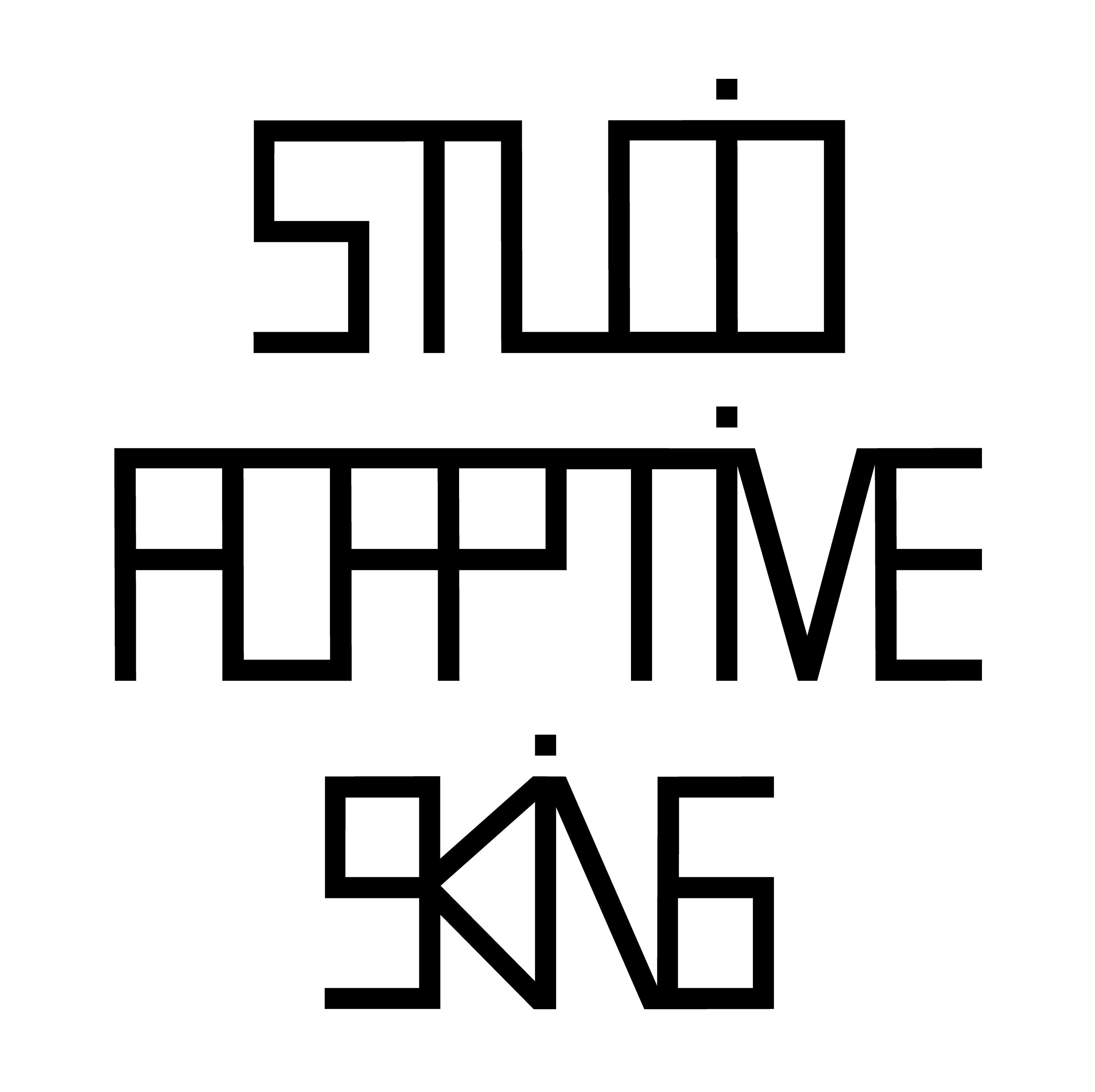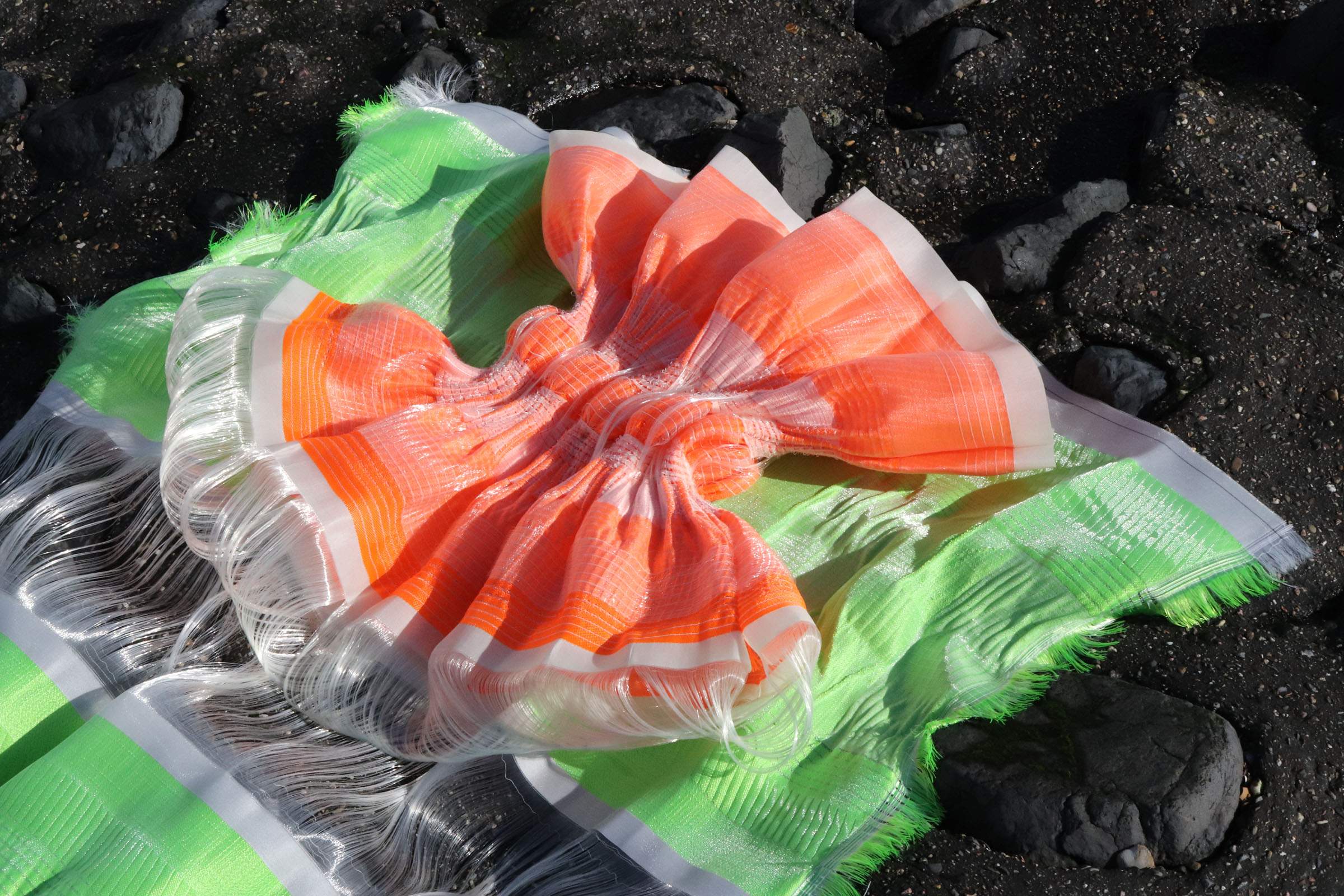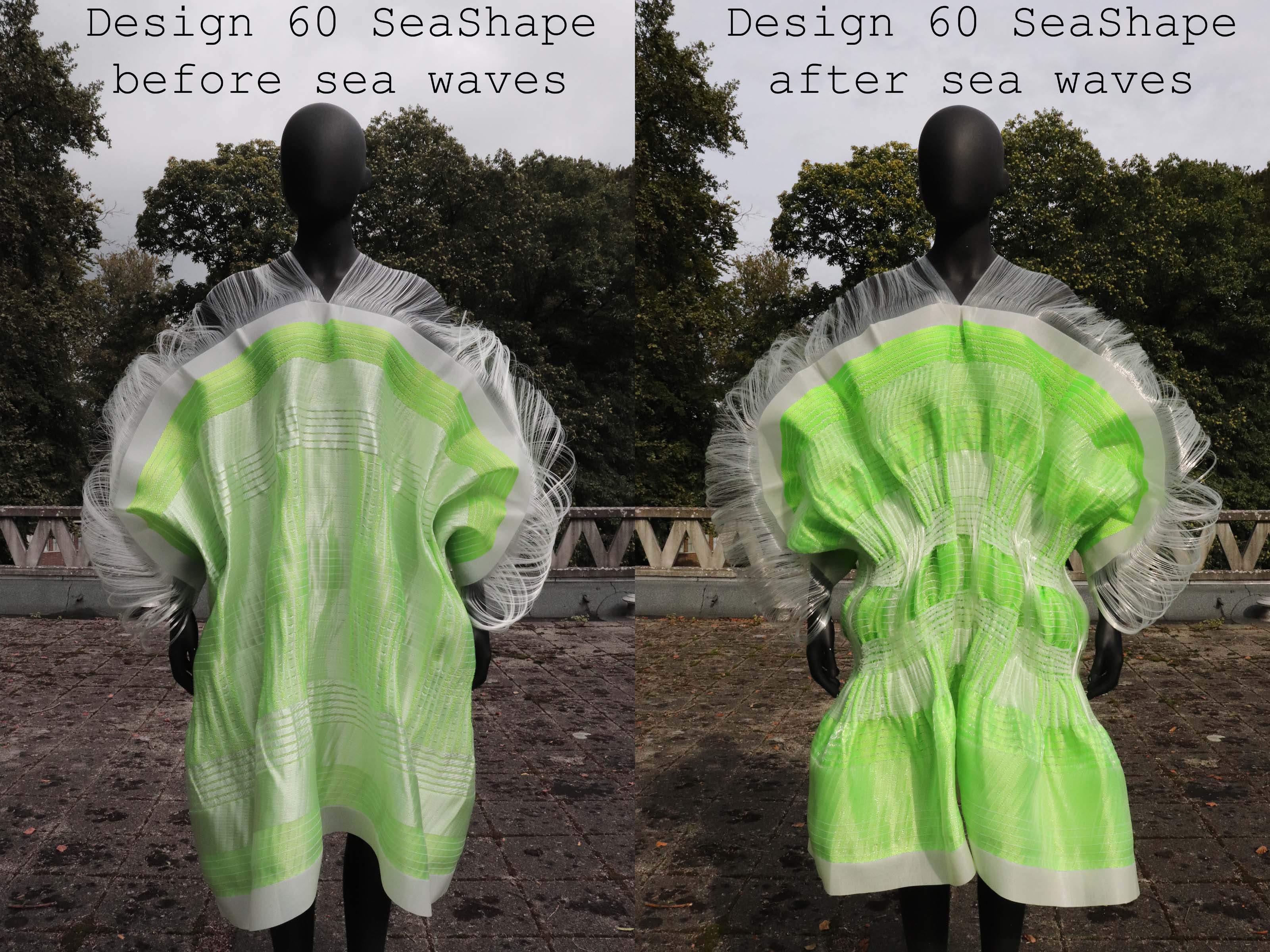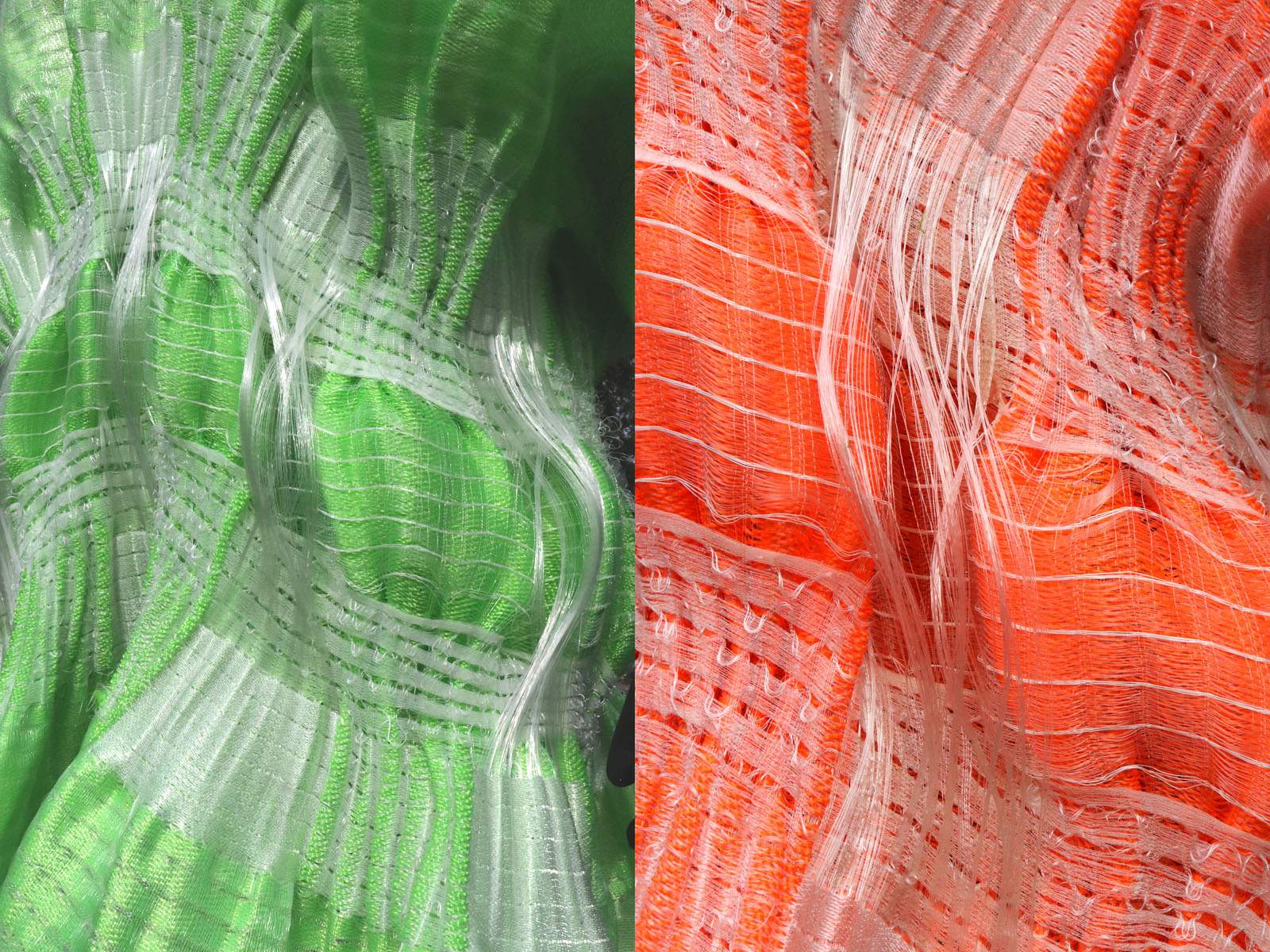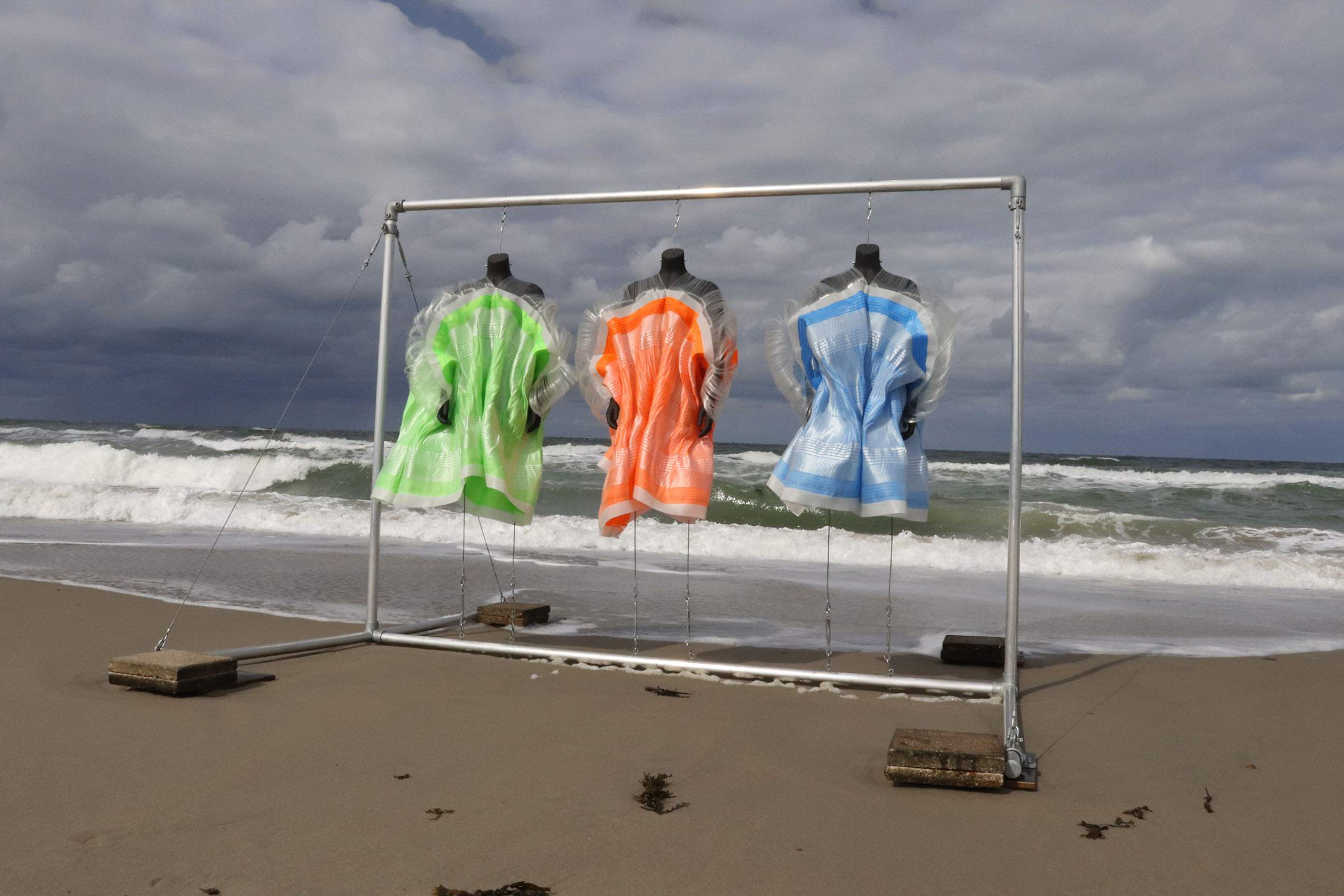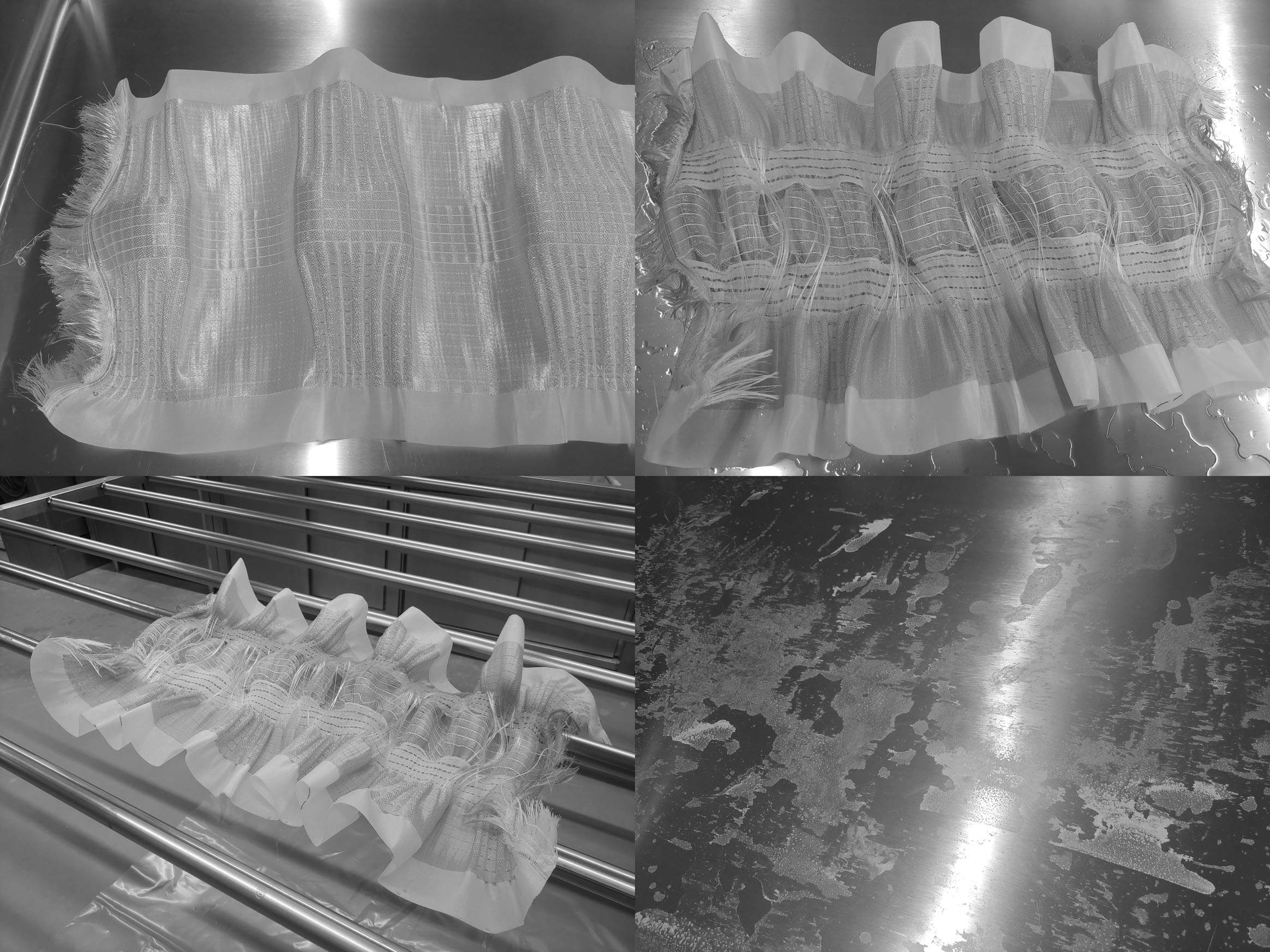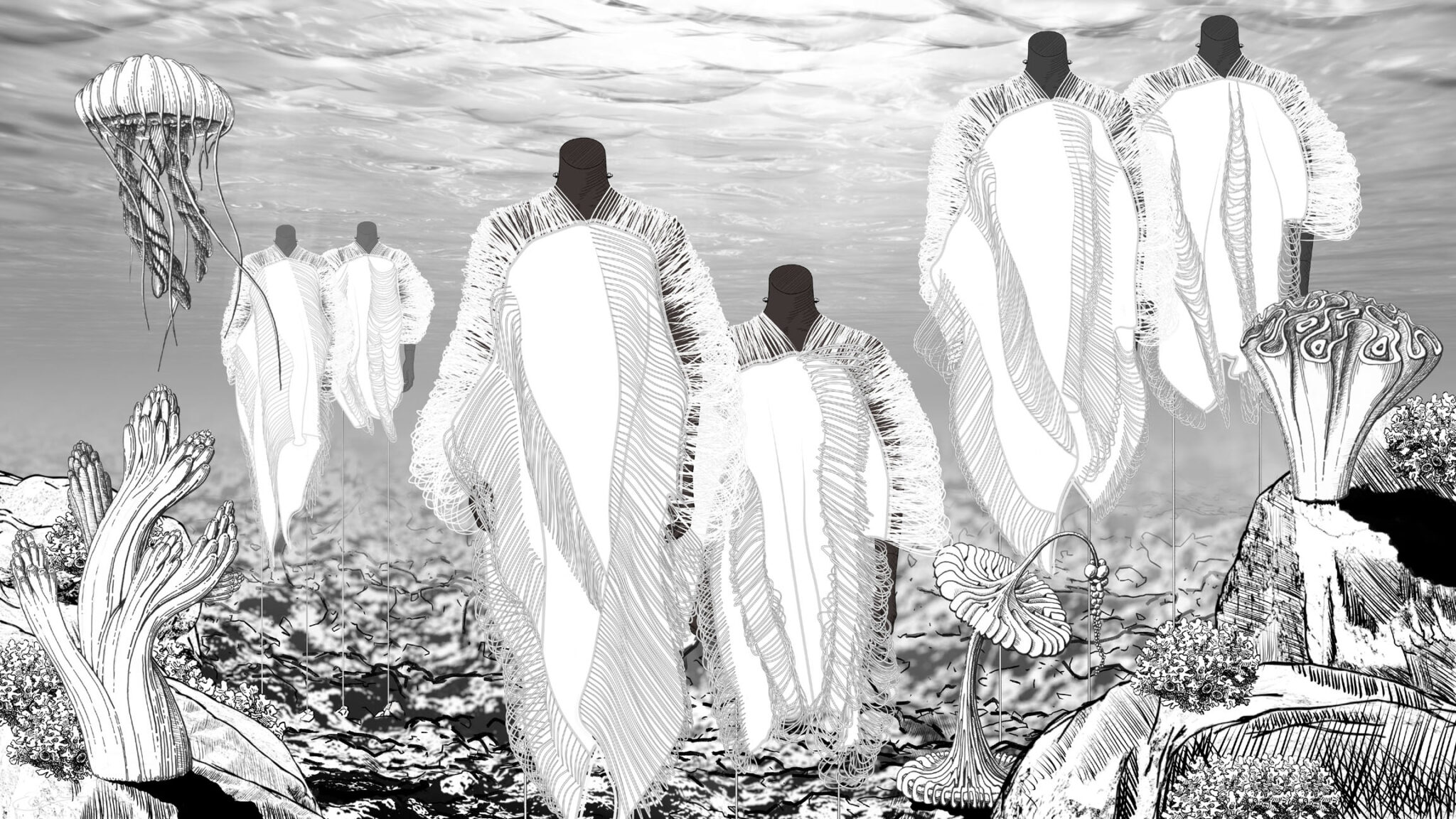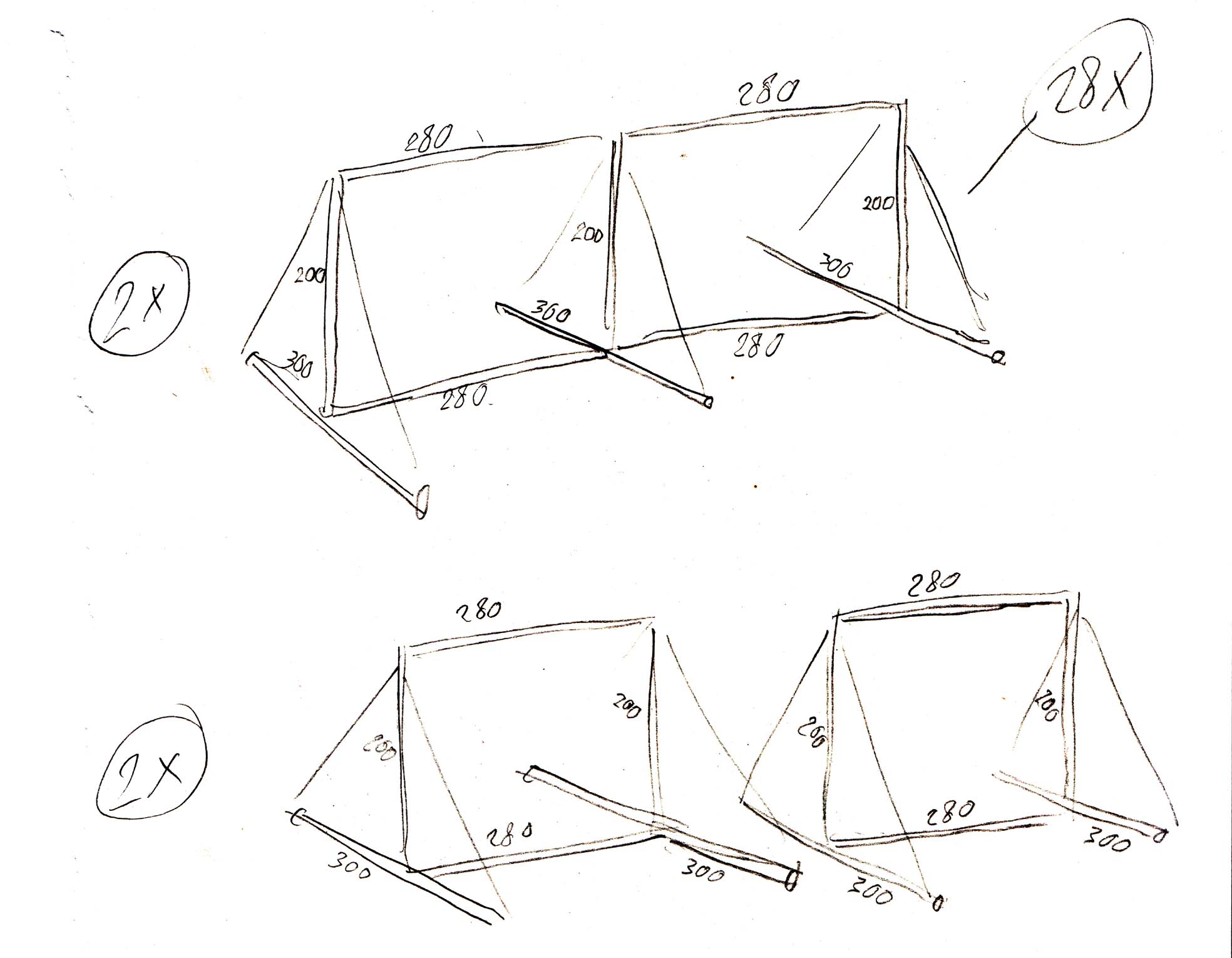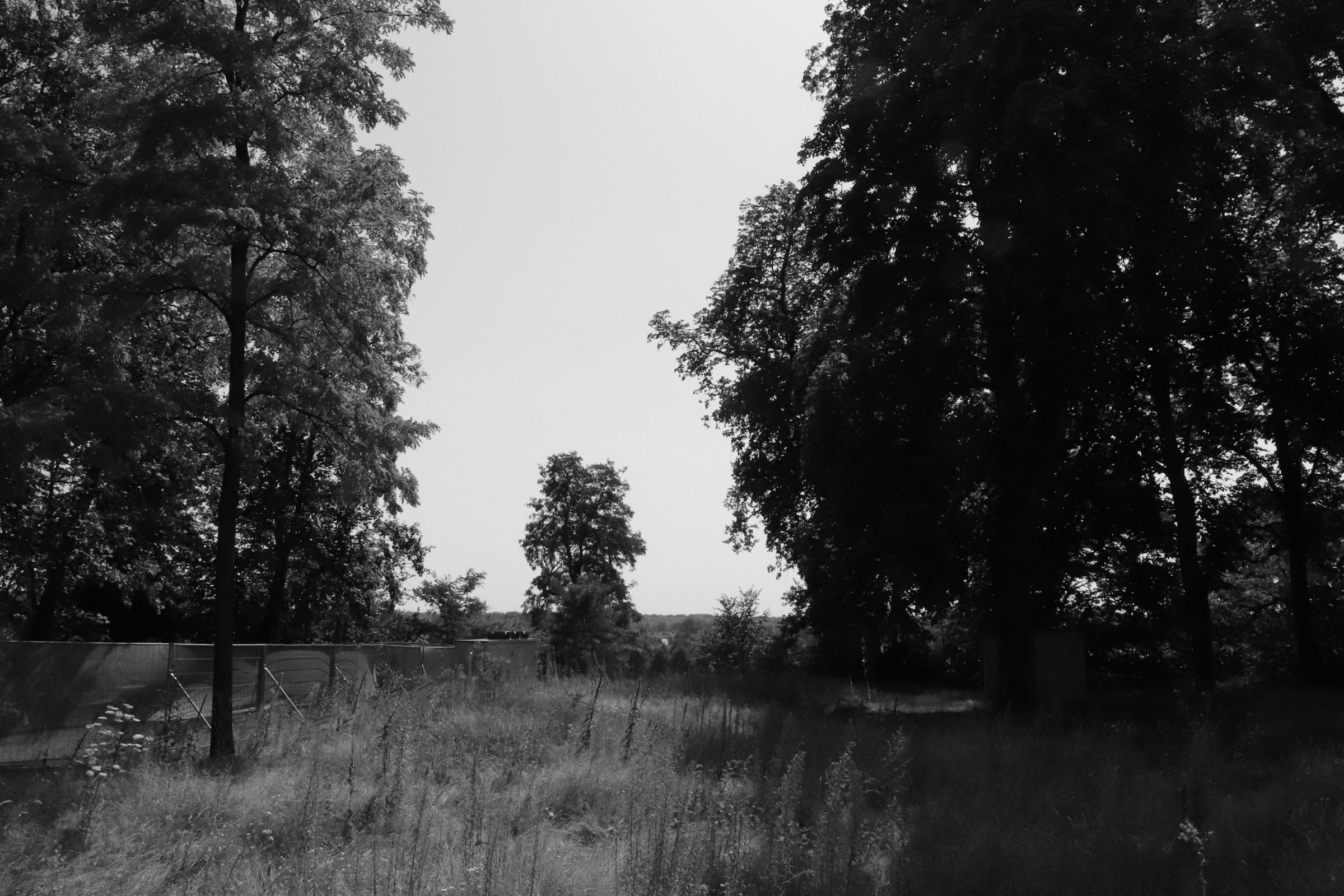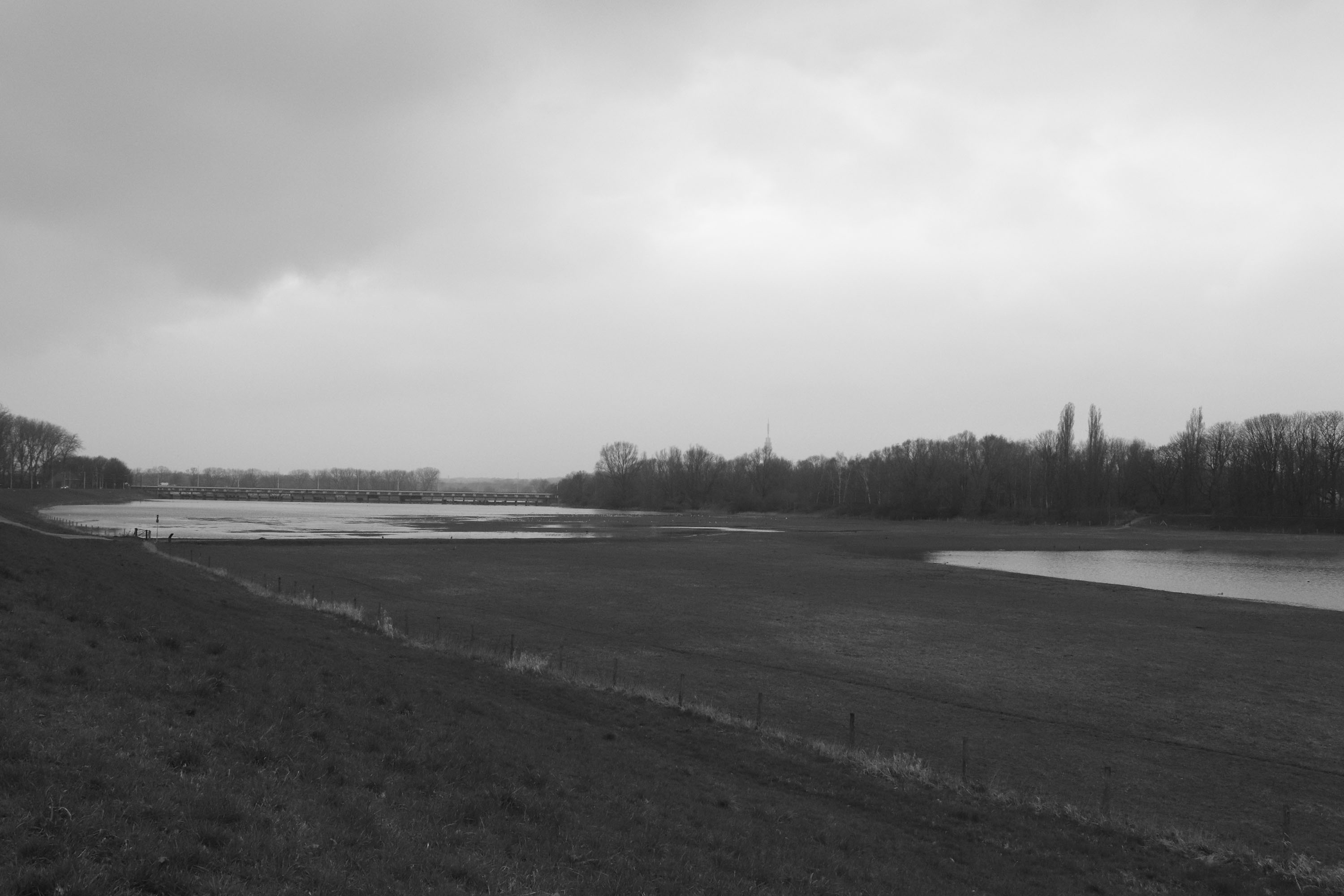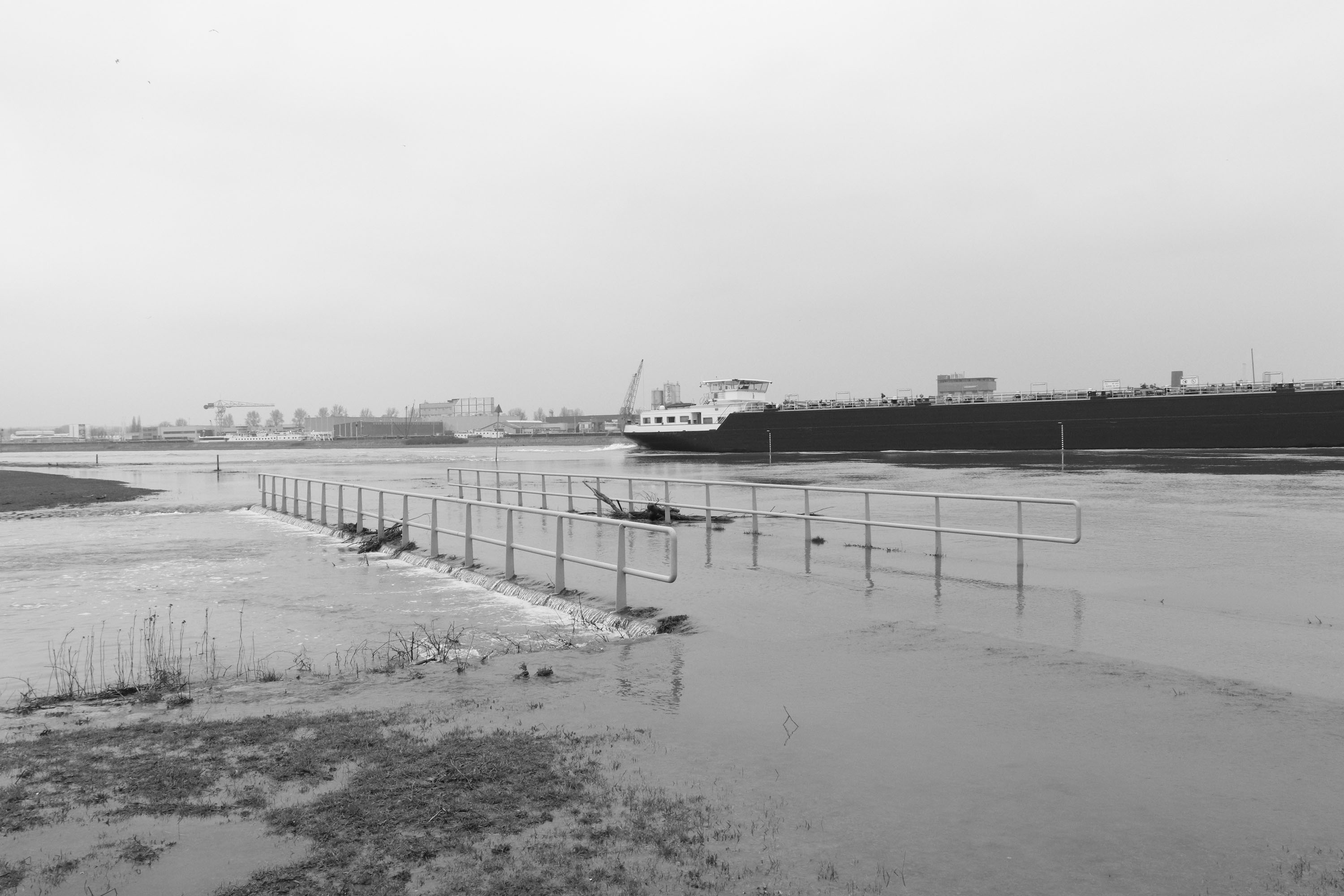-
Update 20: 12-10-2022
Underneath you can find an overview of pictures that Nathanael Cardenas made during the fashion manufactured by sea waves experiment. The before and after effect pictures on the roof of B46 studio in Arnhem were taken by Jef Montes. The credits for the short video of project SeaShape are:
Creative direction: Jef Montes
Video: Maarten Verbaarschot and Nathánaël Cárdenas Meijers
Music: Ralph Timmermans
Materials: Aitex Textile Institute Alcoy
Textiles: TextielLab Tilburg
Installation: Bart Nijboer
With support from Creative Industries Fund NL
-
Update 19: 18-09-2022
On the 14th of September photographers Maarten Verbaarschot and Nathanael Cardenas agreed to have a creative collaboration with eachother in Zeeland. We brought the adaptive SeaShape materials, including the installation that artist Bart Nijboer made, to the North sea and we did an experiment with textiles that deform below seawater. It was quite a logistic challenge to arrange the shipping, but luckily I had the help of two amazing people to make this all happen. Maarten arranged enough photography and filming equipment in order to do an excellent documentation. We were able to travel with the car from Maarten and use a storage trailer to put the entire installation inside. Our small team went to stay a few days at a cozy camping that was near the Westkapelle beach. We did check the weather predictions, but it will always stay a risk to go and see what happens in terms of the weather. On Thursday the 15th we went to the Westkapelle carbeach and we brought some wet-suits with us to work inside the water without getting too cold. Luckily we had an interesting day with lots of good weather to be able to do the entire documentation. So many things have could gone wrong, but luckily this beautiful day was on our side. It was a tough job for each and single one of us, and I want to double thank these amazing two guys that did this adventure with me. All the shout outs and props goes out to you. Thanks a lot Maarten Verbaarschot and Nathanael Cardenas! I also really enjoyed our nice dinners and talks together. The journey is just as important as the final destination!
-
Update 18: 12-09-2022
Finishing the full pattern presented a very technical challenge. I could easily finish the edges around the fabric with the heat press. I couldn't heat the fixing threads in the middle of the pattern with the heat press. This had to do with the heat press having an arm, so I couldn't slide the woven pattern any further under the heat press. I was able to apply a heat press without an arm, this just required a lot of extra patience and manual work with care. The first woven production had to be redone, this had to do with incorrectly added yarns around the middle part of the woven pattern. As a result, yarns melted under the heat press, and this was unfortunately very visible. I was very grateful to Judith and the weavers for wanting to redo this free of charge. The idea of the TextielMuseum was perhaps partly to place the incorrectly woven cloths in the sample studio. I also thought this was a good idea. All in all, everything went well!
-
Update 17: 06-09-2022
Project SeaShape is a sequal after project Marinero. The idea is to go from rainwater towards seawater, and experiment how the waves of the sea contribute to shape the adaptive textiles around 3 mannequin bodies. I was able to work an entire week in the TextielLab at TextielMuseum Tilburg. During this week I collaborated with product developer Judith Peskens. She is one of the amazing product developers that works on the jacquard weaving machine. Judith introduced me to one of the new weavers Alonzo. It has been very nice to communicate and learn about his background in the textile industry. He seems to be very happy to be working on the creative that are developed at TextielLab. The weavers are crucial team members that help to produce the fabrics that the product developer prepares on the computer.
Project SeaShape
-
-
Update 16: 26-08-2022
The summer of the year 2022 has been pretty intense. The effect of global warming is coming closer and closer, with the result of extreme weather. The drought caused many rivers to drop water levels extremely low. The trees are already starting to shed their leaves during the summer. This is a natural reaction so that the trees do not die from the drought. The leaves fall to the ground around the tree, to counteract the dryness of the soil. Even the water ditches in my own neighborhood has dropped until they were completely dry! At the same time all over Europe news reports start popping up around the exploratory vibe that surrounds the topic of drought. It seems that people are inspired by this phenomenon, because water levels dropping also unfold hidden treasures such as for example: in Spain, the drought exposed a 5 millennium old stone circle monument, in Germany the so-called hunger stones from the past droughts are resurfacing along the Rhine river (1959), and in Serbia the Danube River has exposed the wreckage of a Nazi fleet that has been at the bottom for nearly eight decades. There's a lot of fear surrounding global warming and its environmental impact, but it's both interesting and disturbing to experience the other end of the spectrum that people also see the beauty around this topic. In my own experience I found a ditch in Arnhem near the Rhine river that was completely dry. At first I was a bit shocked that I could see the effect of drought so close to my own home. So, I went exploring and made an overview of the things that I found. To me personally I get frightened when nature wants to warn us humans through extreme weather. In my own projects I have had the desire to work with natural forces and to really listen to natures beauty of creation. Nature = creation and its power could be infinite, but humans in general are the ones that could disrupt natural balance. What if nature decides that humans are the threat for the future of our planet. What if the result would be endless unbearable extreme weather, until non of us are left? This could be a reality. In my work my aim is to create awareness that humans need to be more humble and respectful when it comes to harming the environment. Natures balance is very precious and fragile, and when it's too late it could mean that all humans need to leave the planet. But, there is no planet B! So, the million dollar question still remains unanswered. The fact is that we are here and all we can do is stay, but will hope be enough in order that balance will be restored? We are the ones that can turn hope into reality.
-
Update 15: 05-02-2021
The rising of the Rhine river still fascinates me a lot, especially during this period of global warming. Sometimes I have dreams about the dikes that will break due to excessive water rise. It has already happened across Europe several times the last couple of years, that unforeseen water damage destroy complete cities. I am not really scared about that it might also happen soon in Arnhem, but the topic just keeps my curiosity senses alive! But what if it does?, I will be sure that us Dutch people will have good protocols for that! Even so, this environmental edgy behavior inspires me in some way. Some things just don't have or need an explanation why we focus on the things that somehow triggers our intuition as human beings. I have been wanting to work with natural elements, water streams versus the effect of yarns and textile techniques. I am currently working on a new project called ''SEASHAPE''. I would like to continue what we have worked on with Re-FREAM (fashion manufactured by rain), and to bring the installations to the North sea, meaning below the salty water! To create a new experiment and of course new materials and textile that will interact with the environment. I have been working since many years with the elements of nature, and I would like to dedicate the fact of materials that are grown underwater absolutely fascinate me as a designer! I will keep this project alive and up to date on the research section of Adaptive Skins. Also, I will be working on a new project called SPYROGIRA, materials that are grown/manipulated by living underwater organisms. More of that will be updated soon as well!
Marinero - fashion manufacturedd by rain installation - experiment overview
-
Update 14: 09-01-2021
During the installation build up process I asked Bart Nijboer to help me to install everything on the roof top. There was no working elevator in the building, so we spend a few days bringing everything to the roof. It took 1 day extra to install all 4 installations on the roof platform. I was very happy that Bart helped me to build up everything. He knows all the ins and outs of his installation design. We bumped into a few technical issues that Bart could solve very fast. I could not have done it so well myself. So, I am very thankful for his helping hands and adaptive insights.
I decided to start with 6 weaving designs ( seaweed category ) and 6 knitting designs ( mix category ). Starting with 12 designs, to be able to complete the total of 36 garments. There are 4 installations with 6 mannequins inside each installations. The idea is to begin with the first 12 in September and October and to finish the remaining 24 in November and December 2020. Starting this process is always very exciting, because you will always find nice surprises along the way. I am planning to use the first 12 as a trial and learn what I want to adjust, following up towards the second and last experiment.
-
Update 13: 13-10-2020
The final update for the installation plans have been completely changed during the corona crisis. I have been in contact with project partners Aitex, Empa and Ars Electronica. Initially we agreed on shipping the installations to Spain, Switzerland and Austria mid July. But I changed my mind to keep everything inside the boarders of the Netherlands. This way there is no big risk for me to travel and put myself in rapid shifting lockdown situations.
After a long search for several locations, I came to the conclusion to just pick the strongest option. We began to think big, but in the end it’s best to zoom into the essence of what you are doing. In my case I just need a good roof top, that is big enough for my installations. My journey all over Europe brought me back to the place where it all began, my studio office rooftop. After I cancelled all the installations in Europe, I went back to my own rooftop in Arnhem and I came to the conclusion that all installations would fit on this exact spot. Next to that, I could record the time-lapse of all installations combined at one location. Image-wise I believe this would be the most powerful documentation frame. I am happy about this outcome.
-
Update 12: 06-06-2020
Sonsbeek forest in Arnhem has been added to the list of official tailored by weather locations. I needed to contact the government and apply for a legal expo location permit. Medio May I got the confirmation that my team can build the installation between July and December 2020. The design of the Sonsbeek installation will be a different version. We are going to hang the installation between two trees. This will be done by using steel wires. Bart will help me throughout this whole process. The timelapse camera will be constructed high up in one of the nearby surrounded trees.
If you are curious about these plans, then focus on my upcoming blogs. I will be sharing more images and clips about this process.
The confirmed locations now are:
- 1: Alcoy @ Aitex textile institute ( 2020 )
- 2: St. Gallen @ Empa material laboratories ( 2020 )
- 3: Arnhem @ B46 Kema chemistry laboratories ( 2020 )
- 4: Arnhem @ Sonsbeek forest ( 2020 )
-
Update 11: 30-04-2020
Bart Nijboer is a fine-artist from Arnhem. His work is inspired by nature and he creates kinetic objects. It was very inspiring for me to work with Bart. He has the technical knowledge to be able to create what I had inside my mind. Our collaboration started with creating some initial sketches and we made a list for materials that needed to be bought. It was quite a challenge to buy all the materials 1 by 1 from the construction markets. Luckily Bart helped me by forwarding all the suitable options and looking together what works the best. He also made a work plan document that really helped to keep everything crystal clear.
The first step was to build the test installation prototype. Bart used aluminium tubes and steel cables to create the foundation of the test installation. We evaluated together and concluded that all installations need to be a bit smaller. The first test seemed to be to large to fit on the Aitex institute rooftop. Some minor adjustments needed to be made in order to start finishing most of the other installations. I was very happy with the first tryout. Bart afterwards made some sketches and Lennart Abbing created the technical 3D drawings. The images and manual will help to build the installations. Bart will make packages per installation and we will ship them afterwards to the final destinations. Everything will be perfectly sorted and easy to build. I personally think that Bart did an amazing job! Looking forward working with him again.
-
Update 10: 30-04-2020
4 material installations are going to be developed for project Re-FREAM. Each installation will have framed garments that belong to a specific TextileLab material category. Bart Nijboer is developing all these material installations. The cities where these installations are going to be placed:
- 1: Alcoy @ Aitex textile institute ( 2020 )
- 2: St. Gallen @ Empa material laboratories ( 2020 )
- 3: Arnhem @ B46 Kema chemistry laboratories ( 2020 )
In Alcoy 1 installation will be constructed into separate parts. These constructions ( 2 x 3 torsos ) will be placed on 2 different spots on the roof of Aitex. In St.Gallen 2 installations will be constructed on the roof of Empa. This roof is big enough to fit 2 entire installations ( 2 x 6 torsos ). In Arnhem 1 installation will be re-used for 3 separate material experiments ( 1 x 6 torsos ). This means that we will finally reach the total 6 x 6 TextileLab material category experiments.
My idea is to start in Arnhem. This approach seems to be the most logic. The Marinero garments will be produced inside my studio. Afterwards the garments will be brought to the rooftop. This will be the spot where we will start our first tailored by weather experiment. During the coming months I will stay in contact with the Re-FREAM partners about when we can start to build the 3 international installations. The aim is that all tailored by weather installations will stay on the rooftops until January 2021.-
Update 9: 23-03-2020
On the 16th of March I walked near the Rhine river. I saw that once again the river started to rise crossing the countryside. One week later I saw that the water level has dropped again to its original height. This natural development keeps inspiring me to think about my underwater installation. It would be amazing if I could create the ´´tailored by the sea´´ installation in the future. Maybe if I create the right materials I could do a small test in the local river. And maybe later I could think bigger to bring the installation to the sea. For project Re-FREAM I commissioned Dutch illustrator Erik Crins to draw what I have in my mind. Later on medio 2020 I will publish the final result of the illustration.
-
Update 8: 20-02-2020
The first steps to create the tailored by weather installations have been made. Harmen van Liemburg and Bart Nijboer will collaborate with Jef Montes to make it all happen. Harmen and Bart are fine artists and we all work in the same area named ''Former Kema electricity factory / Energy business park Arnhems buiten''. This is very nice because we can collaborate closely and nearby together. Jef will focus on managing the whole process, Harmen will work on customizing the mannequins, Bart will produce the installations and Lennart will focus on creating the technical drawing + manuals ''how to make the installation''. The mannequins are second hand from Gruppo Corso Utrecht. We will customize the mannequins to make them fit for the time-lapse camera documentations. This means that they will need to be painted black, to create a contrast with the white Marinero garments.
During the first meeting on 19-02-2020 we all came came together to test the mannequin holes drilling and steel wire hanging construction variations. We made a working plan on how to make the mannequins fit isolated within the steel construction frame. The idea is that the mannequins must not move during the filming process (day and night filming for max 2 months). There will be more challenges involved following up towards the deadlines in May.
-
Update 7: 09-02-2020
The pictures underneath demonstrate the 2 angles taken for the tailored by weather installations. The Aitex roof has a spectacular view, but has limits in terms of floor space. We chose to split the original construction design into 2 parts. This means that 2 separate frames need to be produced to fit on the Aitex roof. Another factor is that 2 time-lapse camera's need to be placed on the roof to capture both installation process. The idea is to have 3 mannequins placed per installation ( 6 mannequins in total for the Aitex roof ). Starting from May till July 2020.
-
Update 6: 08-01-2020
Rough sketch idea of the material installation rooftop Empa in st.Gallen. More updates will follow the next few months. The sketch demonstrates the construction that needs to be still designed and build later on in April 2020.
Important questions about the installations are:
- needs to be windproof. I need help to make the construction
- can I maybe get help to make this installation / or do I need to organize this myself?
- each installation needs to adapt depending the layout of the roof. So it's important to know how this layout looks per roof?
-
Update 5: 24-12-2019
Interesting developments have been taking place with the water wire material installation. Initially Studio Adaptive Skins member Jef had the idea to place all the 30 material designs within the forest of Arnhem. But working with project Re-FREAM opened new doors for Studio Adaptive Skins. The project is running well and new connections are made. Collaborating partners offered their spaces as a possible location for the Marinero material rain installation. It seems more interesting to place the installation within international scale. Also from a design research point of view it seems very beneficial to collect all data from different weather conditions in different cities. All installation placed within the same moth of May 2020. The main question will be: ''how do these different weather conditions have an effect on the material designs?'' -> We will find out within the end fase of the project -> June 2020.
So far the plan is scheduled to place 6 material designs in each city, depending how many locations we could receive. This means that I will also need to have 6 locations. But maybe we can combine 6 or 12 within one or two cities. We will adapt to what seems logical and natural.
- The confirmed locations now are: Aitex in Alcoy and Empa in st Gallen.
- Evaluation status: Grand Garage in Linz and Sonsbeek forest in Arnhem
- six weaving material designs in Spain
- six weaving material designs in Switzerland
-
six weaving material designs in Austria
-
six weaving material designs in Holland
-
six weaving material designs in ?
- six weaving material designs in ?
Knitting category:
- * ( special edition ) six knitting material designs in ?
Credits photo: st.Gallen Empa administration building rooftop - photo's by: Studio Adaptive Skins
-
Update 4
On 30-07-2019 I made a sketch of my favourite spot inside the forest of Sonsbeek park. The sketch demonstrates the idea of the water wire installation hanging between 2 beech trees. The exact amount of garments attached to the water wire installation is still unknown. The aim would be around 20 up to -> 30 garments maximum. It would be interesting if Studio Adaptive Skins could join the statue-exhibition Sonsbeek park 2020. The exhibition lasts 100 days starting from June 2020. Those months are good for the installation to receive: heat, humidity and rain.
-
Update 3
The first experiment of Marinero was done on the rooftop of my studio in Arnhem. The national late 1930’s monument was a former nature and chemistry laboratory of the electricity organisation Kema. The building was designed by architects: G. Hamerpagt, H. Fels and prof.ir. R.L.A Schoenenmaker. The Arnhems buiten area seems like a good second option to do the water wire experiment. It's near my studio office and the area has a strong forest feel. On 29-07-2019 I did a photo testing shoot to see if I could find potentials spots to do the experiment. The spots that I found were interesting but not as strong as Sonsbeek park. Arnhems Buiten will be the second. The focus first will be to follow up and research if I can get a permit to do the water wire experiment inside the forest of Sonsbeek park.
-
Update 2
On 26-07-2019 I had a follow up meeting with the forester at sonsbeek park Arnhem. We drove around in his car and he took me to a place where he felt that it could be a good fit for my installation. He brought me to the heart of the forest. It was surprising to me because this is my favorite area inside sonsbeek park. I have experienced many special moments throughout my life at the heart of the forest. It was interesting for me to hear why the forester brought me to that specific area. I found out that this part of the forest is actually dying. The trees can reach the maximum age of 300 years. The current age of the beech trees are about 250 years old. The dying process of the trees happens underneath the soil. There is a fungus underneath the soil that allows the trees to die. New trees will rise and start a new era of regrowth. This is very inspiring to me because it makes an interesting connection with the deformation process of my installation. I started to do the photography test at the heart of the forest. During that process I found a spot where the water wire installation could hang between 2 beech trees. Maybe 3 wires above each other depending the quantity of the garments. The backdrop is contrasting enough to do the documentation. I believe that this spot has great potential.
-
Update 1
After doing the ACT project with the research university Wageningen we came to the conclusion that the first stage of project Marinero will have the best process within the forest context. The deformation process under the water needs to be more developed in another future stage of the project. For the first stage I will work with the mono-filament ( plastic yarn ) chain from the TextileLab jacquard machine. The added yarns will be sea-based in combination with shrinking yarns. The first stage will be about the contrast between sea-based and plastic recycled from the sea. For the second stage I want to research how we can follow up towards a sustainable and fully sea-based developed prototype. The idea is to let go the plastic and think about what can be the new plastic? Maybe fishbones can be an interesting option. I believe that the Re-FREAM platform and their network with scientists can support me on that journey.
Inside the forest I can control more the effect of microplastics dripping from the materials towards the soil. I could cover the soil with a special protection material. Or I could for example find a forest area where the water dripping falls on a concrete floor. The water wire installation will not harm birds or insects. During experiment 1 & 2 I saw that the material does not attract birds. Maybe on a wire the birds will find it more interesting. But the material itself is not harmful to the forest animals.
On 24-07-2019 I had a meeting with the creative industry advisor and the forester from the Gemeente Arnhem. Together with them I am looking for a new location within the forest area of Arnhem. I have a specific idea about how I want the area to look like. But it was also interesting to hear the point of view from gemeente Arnhem. They think that it could be an addition that the water wire installation will be placed during a special event - for example: beeldententoonstelling ( statue exhibition ) sonsbeek park. I will keep an open mind to alternative external ideas. My main focus is that the collection will be woven during a specific time that I don't know exactly yet. So the time and exact exhibition place will be adaptable until the last moment. My main criteria is that I need a small space or cabin inside the forest where I can sit dry and document the material process. The video and photo documentation is very important to capture during the water wire experiment.
I went to look at the first option: ''Museum Arnhem''. At first it sounded good on paper as a story. But during the photography test I realized that there was to much sky in the background of the image. It does not work from a photographic point of view. It is a beautiful location but not fit for my experiment. I believe that a forest location somewhere else in Arnhem would be a better option. The darkness of the trees in combination with the white materials will have enough contrast to capture on image. Other requirements would be that the location needs to be open enough to receive a lot of sun and rain.
Until so far my gut feeling is going more towards my studio office area ''Arnhems Buiten'' ( experiment 1 & 2 forest area )
The journey continues!
-
Early 2020 I have the idea to hang collection Marinero on a wire near the Rijn Arnhem. Together with Gemeente Arnhem we are discussing about the possibilities to place the clothing wire underneath the water. I will need to get permission from Rijkswaterstaat to do this experiment. On 20-03-2019 I looked at the fields next to the Rijn that Gemeente Arnhem has pointed out to me as a possible location. During this time of year the water level of the Rijn (Rhine river) rises. The photo documentation underneath shows the effect of the water rise. After experiment 1 and 2 I will work on using sea based materials in combination with recycled plastic and shrinking yarns. I need the environment to let the designed woven blueprints take shape. Each prototype will be photographed before and after the water wire experiment. The entire Rijn experiment proces will be filmed and presented as a timelapse. You will see the whole collection hanging on a wire. The water of the Rijn will rise and the collection will stay underwater until the water level drops again. The material starts working underneath the water causing the shapes to deform organically. All garments have the same base blueprints but have a variety in materials and bindings. The reason why I am doing this is that I want nature to have a role in the shaping process of a design. The blueprints are inspired by elemental shapes. These patterns are also found in growing plants. This concept is translated into the blueprint design of Marinero. I will develop the technical drawings for the weaving patterns. They will be divided in several weaving techniques. I will base the design decisions on what I think that will have an effect later during the transformation process. What exactly will happen is not precisely known yet. But experiments 1 and 2 show an indication about what could happen. These two designs have the same blueprint but have such a diverse variety in how it responds to the environment and the human body. I expect the same variety to happen with the water wire. This page will be updated regularly until the water line experiment is completed.
